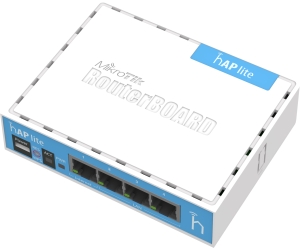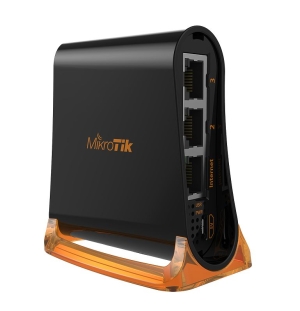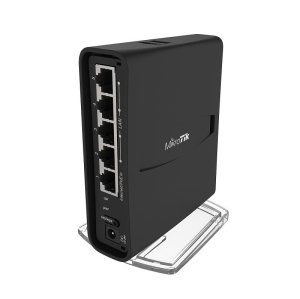TELTONIKA Industrial Ethernet Wi-Fi 4 Router (RUT140)
1x 10/100 Mbps WAN port | 1x 10/100 Mbps LAN port | Wi-Fi 4 (IEEE 802.11b/g/n) | Dual powering ( PoE-IN, 3-pin industrial DC power socket, 9-30 VDC), (no PSU included) | Full aluminum housing | Integrated DIN rail | RMS
| Price:[i] | For orders (total sum):[i] |
| 56.10$ | >0$ |
| >500$ | |
| >1000$ | |
| >5000$ | |
| >10000$ | |
|
Out of stock
|
|
Features:
The RUT140 is a compact industrial Ethernet router, enhancing security through network isolation for end devices. Equipped with two Ethernet ports, DIN rail bracket, and an industrial 3-pin connector, it ensures seamless connectivity and easy installation. The router comes with RutOS, Wi-Fi 4, and supports industrial protocols such as Modbus, DLMS, DNP3, and OPC UA, and is compatible with RMS for efficient remote and on-site management.
Specification:
Wireless
Wireless mode: IEEE 802.11b/g/n, Access Point (AP), Station (STA)
Wi-Fi security: WPA2-Enterprise - PEAP, WPA2-PSK, WPA-EAP, WPA-PSK, WPA3-SAE, WPA3-EAP, OWE; AES-CCMP, TKIP, Auto-cipher modes, client separation, EAP-TLS with PKCS#12 certificates, disable auto-reconnect
SSID/ESSID: ESSID stealth mode
Wi-Fi users: Up to 50 simultaneous connections
Wireless Connectivity Features: Wireless mesh (802.11s), fast roaming (802.11r), Relayd, BSS transition management (802.11v), radio resource measurement (802.11k)
Wireless MAC filter: Whitelist, blacklist
Wireless QR code generator: Once scanned, a user will automatically enter your network without needing to input login information
Ethernet
WAN: 1 x WAN port 10/100 Mbps, compliance with IEEE 802.3, IEEE 802.3u, 802.3az standards, supports auto MDI/MDIX crossover
LAN: 1 x LAN ports, 10/100 Mbps, compliance with IEEE 802.3, IEEE 802.3u, 802.3az standards, supports auto MDI/MDIX crossover
Network
Routing: Static routing, Dynamic routing (BGP, OSPF v2, RIP v1/v2, EIGRP, NHRP), Policy based routing
Network protocols: TCP, UDP, IPv4, IPv6, ICMP, NTP, DNS, HTTP, HTTPS, FTP, SMTP, SSL v3, TLS, ARP, VRRP, PPP, PPPoE, UPNP, SSH, DHCP, Telnet, SMPP, SNMP, MQTT, Wake On Lan (WOL)
VoIP passthrough support: H.323 and SIP-alg protocol NAT helpers, allowing proper routing of VoIP packets
Connection monitoring: Ping Reboot, Wget Reboot, Periodic Reboot, LCP and ICMP for link inspection
Firewall: Port forward, traffic rules, custom rules
Firewall status page: View all your Firewall statistics, rules, and rule counters
Ports management: View device ports, enable and disable each of them, turn auto-configuration on or off, change their transmission speed, and so on
Network topology: Visual representation of your network, showing which devices are connected to which other devices
DHCP: Static and dynamic IP allocation, DHCP relay, DHCP server configuration, status, static leases: MAC with wildcards
QoS / Smart Queue Management (SQM): Traffic priority queuing by source/destination, service, protocol or port, WMM, 802.11e
DDNS: Supported >25 service providers, others can be configured manually
Network backup: Wi-Fi WAN, VRRP, Wired options, each of which can be used as an automatic Failover
Load balancing: Balance Internet traffic over multiple WAN connections
Hotspot: Captive portal (hotspot), internal/external Radius server, Radius MAC authentication, SMS authorisation, internal/external landing page, walled garden, user scripts, URL parameters, user groups, individual user or group limitations, user management, 9 default customisable themes and optionality to upload and download customised hotspot themes
SSHFS: Possibility to mount remote file system via SSH protocol
Security
Authentication: Pre-shared key, digital certificates, X.509 certificates, TACACS+, Radius, IP & login attempts block, time-based login blocking, built-in random password generator
Firewall: Pre-configured firewall rules can be enabled via WebUI, unlimited firewall configuration via CLI; DMZ; NAT; NAT-T
Attack prevention: DDOS prevention (SYN flood protection, SSH attack prevention, HTTP/HTTPS attack prevention), port scan prevention (SYN-FIN, SYN-RST, X-mas, NULL flags, FIN scan attacks)
VLAN: Port and tag-based VLAN separation
WEB filter: Blacklist for blocking out unwanted websites, Whitelist for specifying allowed sites only
Access control: Flexible access control of SSH, Web interface, CLI and Telnet
VPN
OpenVPN: Multiple clients and a server can run simultaneously, 27 encryption methods
OpenVPN Encryption: DES-CBC 64, RC2-CBC 128, DES-EDE-CBC 128, DES-EDE3-CBC 192, DESX-CBC 192, BF-CBC 128, RC2-40-CBC 40, CAST5-CBC 128, RC2-64-CBC 64, AES-128-CBC 128, AES-128-CFB 128, AES-128-CFB1 128, AES-128-CFB8 128, AES-128-OFB 128, AES-128-GCM 128, AES-192-CFB 192, AES-192-CFB1 192, AES-192-CFB8 192, AES-192-OFB 192, AES-192-CBC 192, AES-192-GCM 192, AES-256-GCM 256, AES-256-CFB 256, AES-256-CFB1 256, AES-256-CFB8 256, AES-256-OFB 256, AES-256-CBC 256
IPsec: IKEv1, IKEv2, with 14 encryption methods for IPsec (3DES, DES, AES128, AES192, AES256, AES128GCM8, AES192GCM8, AES256GCM8, AES128GCM12, AES192GCM12, AES256GCM12, AES128GCM16, AES192GCM16, AES256GCM16)
GRE: GRE tunnel, GRE tunnel over IPsec support
PPTP, L2TP: Client/Server instances can run simultaneously, L2TPv3, L2TP over IPsec support
Stunnel: Proxy designed to add TLS encryption functionality to existing clients and servers without any changes in the program’s code
DMVPN: Method of building scalable IPsec VPNs
SSTP: SSTP client instance support
ZeroTier: ZeroTier VPN client support
WireGuard: WireGuard VPN client and server support
Tinc: Tinc offers encryption, authentication and compression in it's tunnels. Client and server support.
OPC UA
Supported modes: Client, Server
Supported connection types: TCP
MODBUS
Supported modes: Server, Client
Supported connection types: TCP
Custom registers: MODBUS TCP custom register block requests, which read/write to a file inside the router, and can be used to extend MODBUS TCP Client functionality
Supported data formats: 8-bit: INT, UINT; 16-bit: INT, UINT (MSB or LSB first); 32-bit: float, INT, UINT (ABCD (big-endian), DCBA (little-endian), CDAB, BADC), HEX, ASCII
DATA TO SERVER
Protocol: HTTP(S), MQTT, Azure MQTT
Data to server: Extract parameters from multiple sources and different protocols, and send them all to a single server
MQTT GATEWAY
Modbus MQTT Gateway: Allows sending commands and receiving data from MODBUS Server through MQTT broker
DNP3
Supported modes: Station, Outstation
Supported connection: TCP
DLMS
DLMS Support: DLMS - standard protocol for utility meter data exchange
Supported modes: Client
Supported connection types: TCP
API
Teltonika Networks Web API (beta) support: Expand your device's possibilities by using a set of configurable API endpoints to retrieve or change data. For more information, please refer to this documentation: https://developers.teltonika-networks.com
Monitoring & Management
WEB UI: HTTP/HTTPS, status, configuration, FW update, CLI, troubleshoot, multiple event log servers, firmware update availability notifications, event log, system log, kernel log, Internet status
FOTA: Firmware update from server, automatic notification
SSH: SSH (v1, v2)
Email: Receive email message status alerts of various services
TR-069: OpenACS, EasyCwmp, ACSLite, tGem, LibreACS, GenieACS, FreeACS, LibCWMP, Friendly tech, AVSystem
MQTT: MQTT Broker, MQTT publisher
SNMP: SNMP (v1, v2, v3), SNMP Trap
JSON-RPC: Management API over HTTP/HTTPS
RMS: Teltonika Remote Management System (RMS)
IoT Platforms
Cloud of Things: Allows monitoring of: Device name, HW version, Serial number, FW version, WAN IP. Allows actions from the cloud: FW update, Reboot
Cumulocity: Allows monitoring of: Device name, HW version, Serial number, FW version, WAN IP. Allows actions from the cloud: FW update, Reboot
Azure IoT Hub: Allows monitoring of: Wan IP, Number of bytes send/received, Model, Manufacturer, Serial, Revision, FW version and collected data of industrial devices
System Characteristics
CPU: Mediatek, 580 MHz, MIPS 24KEc
RAM: 128 MB, DDR2
FLASH storage: 16 MB serial NOR flash
Firmware / Configuration
WEB UI: Update FW from file, check FW on server, configuration profiles, configuration backup
FOTA: Update FW
RMS: Update FW/configuration for multiple devices at once
Keep settings: Update FW without losing current configuration
Factory settings reset: A full factory reset restores all system settings, including the IP address, PIN, and user data to the default manufacturer's configuration
Firmware customisation
Operating system: RutOS (OpenWrt based Linux OS)
Supported languages: Busybox shell, Lua, C, C++
Development tools: SDK package with build environment provided
GPL customization: You can create your own custom, branded firmware and web page application by changing colours, logos, and other elements in our firmware to fit your or your clients’ needs.
Power
Connector: 3-pos plugable terminal block
Input voltage range: 9-30 VDC, reverse polarity protection, surge protection >31 VDC 10us max
PoE (passive): Passive PoE over spare pairs. Possibility to power up through LAN1 port, not compatible with IEEE802.3af, 802.3at and 802.3bt standards, Mode B, 9 - 30 VDC
Power consumption: Idle: < 1 W / Max: < 2 W
Physical Interfaces
Ethernet: 2 x RJ45 ports, 10/100 Mbps
Status LEDs: 1 x WAN type LED, 1 x LAN type LED, 1 x Power LED
Power: 1 x 3-pin power connector
Antennas: 1 x RP-SMA for Wi-Fi
Reset: Reboot/User default reset/Factory reset button
Other: 1 x Grounding screw
Physical Specification
Casing material: Aluminium housing
Dimensions (W x H x D): 113.10 x 25 x 68.6 mm
Weight: 142.3 g
Mounting options: Integrated DIN rail bracket, wall mount, flat surface (additional kit needed)
Operating Environment
Operating temperature: -40 °C to 75 °C
Operating humidity: 10% to 90% non-condensing
Ingress Protection Rating: IP30
Regulatory & Type Approvals
Regulatory: CE/RED, UKCA, CB, RCM, FCC, IC, EAC, UCRF, WEEE

 WiFi Routers
WiFi Routers  Indoor Access Points (APs)
Indoor Access Points (APs)  Wireless USB Adapters
Wireless USB Adapters  Wifi Extenders
Wifi Extenders  Outdoor Base Stations / Access Points
Outdoor Base Stations / Access Points  Outdoor PtP Units / Backhauls
Outdoor PtP Units / Backhauls  CPEs
CPEs  LoRa products
LoRa products  Antennas
Antennas  3G/4G/LTE
3G/4G/LTE  Wireless Print Servers
Wireless Print Servers  Mikrotik RouterBoards
Mikrotik RouterBoards  MiniPCI, PCI Network Cards / Adapters
MiniPCI, PCI Network Cards / Adapters  RV, Boats & Yachts
RV, Boats & Yachts  RF Cables and Connectors
RF Cables and Connectors  Enclosures
Enclosures  Accessories
Accessories 
 Switches
Switches  Routers and Firewalls
Routers and Firewalls  Servers
Servers  Controllers
Controllers  ADSL and VDSL
ADSL and VDSL  Powerline
Powerline  VoIP
VoIP  Print Servers
Print Servers  Network Adapters
Network Adapters  Surge Protectors
Surge Protectors  LAN Cables
LAN Cables  Patch Cables
Patch Cables  Connectors
Connectors  Patch Panels
Patch Panels  Accessories
Accessories 
 XPON
XPON  Modules
Modules  Fiber-to-Ethernet Converters
Fiber-to-Ethernet Converters  Optical Cables
Optical Cables  Fiber Patch Cords
Fiber Patch Cords  Optical Pigtails
Optical Pigtails  Splitters / Couplers
Splitters / Couplers  Connectors / Adapters
Connectors / Adapters  Termination & Distribution Boxes
Termination & Distribution Boxes  Accessories
Accessories 
 Cabinets
Cabinets  Patch Panels
Patch Panels  Shelves
Shelves  Accessories
Accessories 
 IP cameras
IP cameras  NVRs
NVRs  Interfaces and Sensors
Interfaces and Sensors  Accessories
Accessories 
 PoE Powering
PoE Powering  Power Supplies
Power Supplies  Power Cables
Power Cables  Batteries / Power Banks
Batteries / Power Banks  Surge Protectors
Surge Protectors  Accessories
Accessories 
 Electric Scooters
Electric Scooters  Vacuum Cleaners
Vacuum Cleaners  Robot Vacuum Cleaners
Robot Vacuum Cleaners  LED Lighting
LED Lighting  USB HUBs
USB HUBs 
 Smart Plugs
Smart Plugs  Smart Bulbs
Smart Bulbs  House Controllers
House Controllers  Motion Sensors
Motion Sensors  Door Sensors
Door Sensors  Home Audio
Home Audio 
 Measurement Devices
Measurement Devices  Tools
Tools 
 Mugs
Mugs  T-Shirts
T-Shirts  Product Catalogues
Product Catalogues  Writing Material
Writing Material  Bags
Bags  Clearance
Clearance  Refurbished
Refurbished  Recommended
Recommended 



























